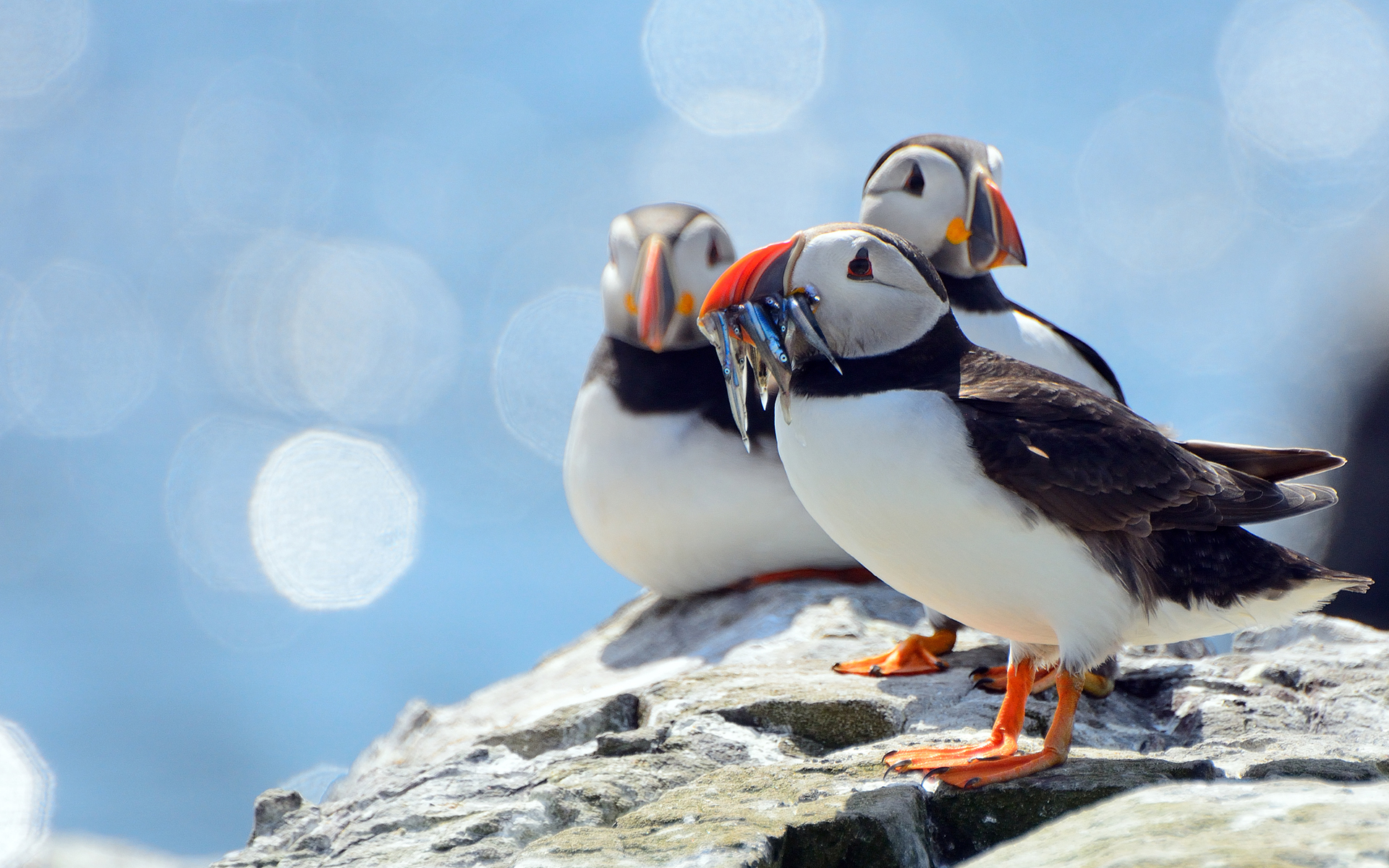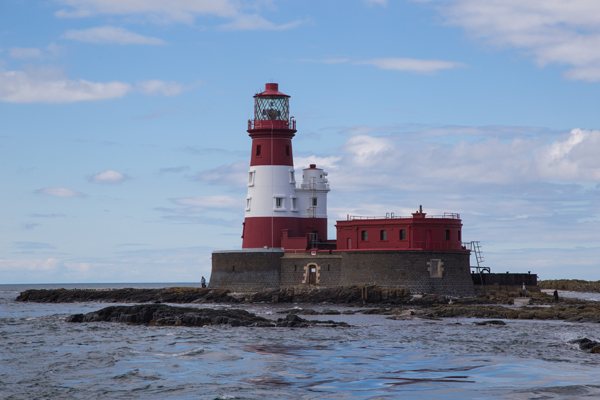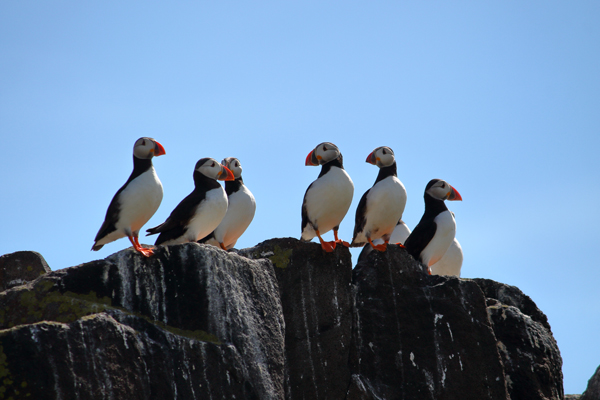
Bird Watching
The Northumberland coast is a birdwatchers paradise. In the summer internationally important numbers of seabirds come to the here to breed. In the autumn, hungry and tired migrant birds stop off to feed for their onward journey and in the winter, wildfowl and waders come from their northern breeding grounds to spend the winter here.
Mid-winter can be one of the most productive times for birdwatching in North Northumberland. Much of the interest will be at sea, with Stag Rocks at Bamburgh a reliable site to look for Long-tailed Ducks, Scoters, Divers and Grebes. The Purple Sandpiper flock there regularly reaches three figures at this time of year, so be sure to scan the rocks at the water’s edge for these unassuming waders.
A walk along any beach can produce Snow Buntings, and listen out for the wheezy calls of Twites overhead. The dunes around Long Nanny in Beadnell Bay are a particularly favoured spot for both of these species.
Holy Island is a great place to visit in January or February. Merlins can be seen sprinting through the dunes after larks and pipits, and be sure to scan the posts on the Pilgrims’ Causeway to look for resting Peregrines. Short-eared and Barn Owls are often in residence and can be seen hunting over the fields during the day. Any visit should include a walk up to the top of the Heugh for a scan of the harbour, where Great Northern Divers and Red-necked Grebes are among the more unusual birds to be looked for.
Spring often comes late to this area, so many wintering birds stay with us long into April. There will be signs of spring, though, and Guillemots and Razorbills in dapper breeding plumage will return to the Farnes before March is out. Shags will be in evidence all along the North Northumberland coast, sporting their shaggy crests for a few weeks at the start of the breeding season.
A few hardy Sand Martins and Wheatears reach the county by the end of March, with the latter being met with both on the coast and in their upland breeding areas. The appearance of these, as well as Meadow Pipits and Skylarks, will tempt Merlins to make their internal county migration back up to the hills, moors and valleys.
Late April is a good time to pay a visit to our inland sites. A walk in Harthope Valley near Wooler should guarantee views of Dippers, with Redstarts singing from the alder woods and Whinchats among gorse and bracken or perched along fences. A walk higher up the valley towards Cheviot could lead to encounters with Ring Ouzels or Ravens, the latter being a relatively recent coloniser following drops in levels of persecution.
May sees the tail-end of spring migration, before the breeding season gets into full swing. This transition makes it an excellent time to be out and about, and a carefully-planned day out can yield well over 100 species in 24 hours. This tally is enhanced by the variety of habitats which can be found so close together in this part of the country, from coastal estuaries and cliffs, through wooded valleys and up to high, open hillsides.
As always during migration times, it is worth keeping an eye on the weather, and easterly winds can produce exotic stray migrants such as Bluethroats, Hoopoes or Golden Orioles.
June is the month for the most feverish activity on the Farne Islands. Thousands of Puffins criss-cross the skies low over Inner Farne, where the brave (or foolhardy) visitor can run the gauntlet of dive-bombing Arctic Terns. For those who prefer their tern experiences to be less interactive, a visit to the ever-growing ternery at the Long Nanny should give good views of four species, including the aptly-named Little Tern.
At the coast in July, there is early evidence of autumn’s approach, with the appearance of the first returning migrant waders. Whimbrels can be heard whistling their arrival, and this time of year gives a good chance to see winter visitors such as Turnstones, Dunlins and Godwits in their smart breeding colours.
The cliffs of the Farnes will be deserted in the early days of July, with the exodus being led by thousands of Guillemot chicks, taking a leap of faith into the surf from their ledges. Puffins stay a little longer and a few linger into August.
Most Farne tern chicks will have fledged by August, but they remain around the islands, often gathering in large, noisy flocks by the jetty on Inner Farne. The three resident species are joined by Roseate Terns, rare seabirds whose only British colony is on Coquet Island, 20 miles to the south. A careful scan of the tern flock should reveal some family parties, the adults being picked out by a combination of paler overall plumage, two-tone red and black bills and bright orange-red legs. Those with an expert ear will be able to pick out their distinctive calls over the constant racket made by other terns.
The terns often take to the air en masse for no apparent reason, before circling together and gradually returning to settle in their original spots. The reason for their jumpiness is often the presence of a predatory Arctic Skua, a bird which will harry any passing tern into giving up its latest fishy meal. Late August brings a visitor from the Falklands and other South Atlantic islands. Sooty Shearwaters complete a remarkable figure-of-eight migration through the year, and onshore breezes can bring them into view, almost always flying north in an effort to get back to the open ocean.
These are the months to expect the unexpected along the coast, so keep an eye on the weather forecast before planning your day out. A drizzly day with easterly winds can be very productive, especially if the weather conditions are fine at the migrants’ jumping off points on northern European coasts.
A ‘fall’ of migrants can be a truly inspiring site, with waves of Redwings and Fieldfares struggling over the waves before diving into the first cover they can find on land. The sight of these winter thrushes making landfall is impressive, but a big arrival of our smallest bird, the Goldcrest, can be even more mind-boggling. These tiny birds can be incredibly tame, even landing on observers when perching options are limited.
Mixed in among the commoner migrants, there is always a liberal scattering of rarer species. Yellow-browed Warblers are regular, especially on Holy Island, along with the odd scarcer relative such as Pallas’s or Radde’s. Also be on the lookout for Siberian strays, such as Red-flanked Bluetails, although the chances are that a gaggle of tripod-toting twitchers is most likely to alert your presence to such a jewel.
Late September sees the return of winter wildfowl. Pink-footed Geese often fill the skies, heading south in ragged skeins, while a barking honk can reveal the presence of Barnacle Geese en route to their Solway wintering grounds. The timing of the Barnacles’ arrival is remarkably consistent, almost always on or around the day of the autumn equinox. Occasionally, adverse weather conditions can persuade them to break their journeys here, when up to 10,000 sometimes cram into Budle Bay.
Pale-bellied Brent Geese, like the Barnacles, come to us from Svalbard, but they are with us for the whole winter. Lindisfarne is the only site in Britain which hosts Brents from this population, and numbers can get up into the low thousands. In recent winters, our pale-bellied Brents have been joined by an increasing number of dark-bellied birds from Siberia, offering a rare chance to see the two races side-by-side.
Late autumn migration continues well into November, with Scandinavian thrushes continuing to arrive in force at this time. It’s not too late for rarities, and the odd Desert Wheatear can appear on a Northumbrian beach.
As always, the Northumbrian birder should keep a careful eye on the weather, paying particular attention to large arrows which indicate strong northerly winds into the upper reaches of the North Sea. This is the signal to get down to a headland for a chance to see an enigmatic little wanderer from the Arctic, the Little Auk. During northerly blows, and sometimes for days afterwards, Little Auks can be seen streaming northwards, trying to re-orientate themselves towards the North Atlantic. Beadnell, Stag Rocks and Lindisfarne are all excellent vantage points from which to watch this phenomenon, although the five-figure national record for the highest number of Little Auks seen in a day comes from the Farnes.
As winter re-asserts its grip, herds of arctic wildfowl graze stubble fields and grace wetlands around Northumberland. Pink-footed Geese have increased here dramatically in recent decades, now outnumbering the longer-established Greylags. The honking of geese and whooping of Whooper Swans provides an evocative sound track to the final days of the year.
The Northumberland coast is a birdwatchers paradise. There are many bird colonies along the coast, the closest being on Beadnell Bay, at the Long Nanny, where five thousand pairs of nesting arctic terns and a few pairs of the very rare little tern make it their home each summer. Then you have the Farne Islands, Coquet Island and the Northumberland wildlife trust at Low Hauxley. To find out further information you can visit Northumberland Coast


